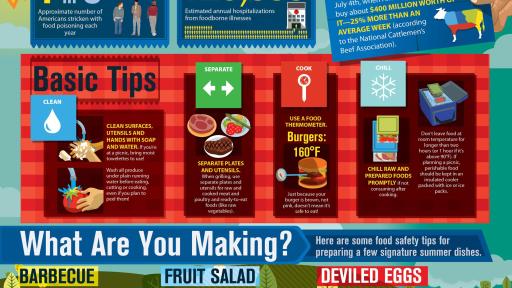USDA and Ad Council Launch New Educational Videos to Help Families Protect Themselves from Food Poisoning this Summer
Summer weather typically causes spike in incidences of food poisoning
PR Newswire, WASHINGTON, DC, July 2, 2015
Millions of Americans are expected to fire up the grills this summer—a time when incidents of foodborne illness, commonly known as food poisoning, tend to surge. In preparation for barbecue season, the Ad Council and the U.S. Department of Agriculture’s Food Safety and Inspection Service (FSIS), are launching a series of new online videos demonstrating the four food safety steps families can take when cooking at home. The videos are an extension of the national Food Safe Families campaign, a multimedia effort created to raise awareness about the risks of food poisoning and motivate consumers to take specific actions to reduce their risk and keep their families healthy.
Foodborne illness is a serious public threat in the United States. The CDC estimates that approximately 1 in 6 Americans (48 million people) suffer from foodborne illness each year, resulting in roughly 128,000 hospitalizations and 3,000 deaths. Because warm weather events often present opportunities for bacteria to thrive and multiply more rapidly, the summer months typically see a spike in reports of foodborne illness and outbreaks.
Additionally, Independence Day is one of the most popular times to grill - with more than 81 million Americans expected to barbecue this July 4th and nearly $400 million worth of beef sold in preparation. USDA research shows that 1 out of every 4 hamburger turns brown before reaching a safe internal temperature. This summer, the USDA is reminding Americans everywhere to “Grill Like a PRO” by taking the necessary food safety steps. One of the easiest ways to avoid foodborne illness is to use a food thermometer when cooking on the grill. Harmful bacteria on burgers, chicken and steak cannot be seen with the naked eye and the only way to know that food is safe to eat is by using a food thermometer. “Grilling Like a PRO” includes:
- P- Place the Thermometer! Check the internal temperature by inserting the thermometer into the thickest part of the meat (usually about (1.5 to 2 inches deep). If you are cooking a thinner piece of meat, like chicken breasts or hamburger patties, insert the thermometer from the side.
- R – Read the Temperature! Wait about 10 to 20 seconds for an accurate temperature. Use the safe internal temperatures guidelines outlined on www.foodsafety.gov for your meat and poultry
- O – Off the Grill! Once the meat and poultry reach their safe minimum internal temperatures, take the food off the grill and place it on a clean platter. Don’t put cooked food on the same platter that held raw meat or poultry.
The new educational videos demonstrates the four main steps people can take to reduce the risk of food poisoning – clean, separate, cook and chill. Each video provides actionable and educational information on specific safe food handling and preparation practices, including how to avoid cross-contamination, use a food thermometer, thaw food properly and clean surfaces and foods thoroughly. The new videos will be shared on FoodSafety.gov and USDA’s social media channels including Facebook and Twitter.
“With so many people planning to picnic and barbecue during hot weather this summer, it’s never been more important to empower them with food safety resources,” said Maria Malagon, Director of Food Safety Education at USDA. “That’s why we created these videos to educate the public about the proper safe food handling behaviors in their kitchens to keep their families safe.”
The Food Safe Families campaign aims to raise awareness about the risk of foodborne illness and encourage families to both learn and practice key steps that will help keep everyone safe from foodborne illness through the following safe food handling behaviors:
- Clean: Wash hands with soap and warm water before and after handling raw food. Clean all surfaces and utensils with soap and hot water. Wash all produce under running water before eating, cutting, or cooking.
- Separate: Use separate plates and utensils to avoid cross-contamination between raw meat, poultry, seafood and eggs and foods that are ready to eat (like already cooked foods or raw vegetables).
- Cook: Cook foods to the safe temperature by using a food thermometer.
- Chill: Chill foods promptly if not consuming immediately after cooking. Don’t leave food at room temperature for longer than two hours, or 1 hour if temperature is above 90°F.
The campaign also includes English and Spanish-language TV, radio, print, and Web advertising, as well as an integrated digital and social media program. All campaign elements direct audiences to visit FoodSafety.gov, where they can learn about food safety practices. Consumers can also access “Ask Karen,” an online database with answers to nearly 1,500 questions related to preventing foodborne illnesses in both English and Spanish. Additionally, the USDA has launched FoodKeeper, an Android and Apple app designed to help people understand how different storing methods affect a product’s shelf life, maximize the storage life foods and beverages in the home, and remind them to use items before they are likely to spoil.
Launched in June of 2011, Food Safe Families is the first joint national multimedia public service campaign designed to help families prevent food poisoning in the home. Since launch, the campaign has received more than $100 million in donated media and campaign website, FoodSafety.gov has educated over more than 25 million visitors. Per the Ad Council model, the PSAs are distributed to media outlets nationwide and run in air time and space donated by the media.
USDA
The USDA’s Food Safety and Inspection Service (www.fsis.usda.gov) is the public health regulatory agency in USDA responsible for ensuring that meat, poultry, and processed egg products are safe, wholesome, and accurately labeled. To accomplish this, FSIS employs approximately 7,600 inspection personnel who enforce the Federal Meat Inspection Act, the Poultry Products Inspection Act, and the Egg Products Inspection Act. During Fiscal Year 2010, FSIS inspection personnel ensured public health requirements were met by inspecting 147 million head of livestock, nine billion poultry carcasses, and 2.6 billion pounds of processed egg products.
The Ad Council
The Ad Council is a private, non-profit organization with a rich history of marshaling volunteer talent from the advertising and media industries to deliver critical messages to the American public. To learn more about the Ad Council and its campaigns, visit www.adcouncil.org, like us on Facebook, follow us on Twitter or view our PSAs on YouTube.
Media Contact
Shirley Yeung
Manager, PR and Social Media
The Ad Council
212-984-1963
[email protected]









